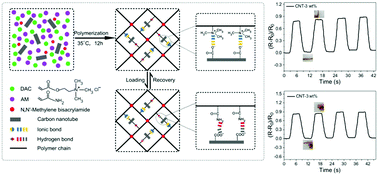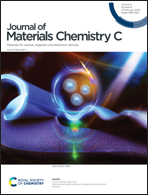Stretchable, compressible, self-healable carbon nanotube mechanically enhanced composite hydrogels with high strain sensitivity†
Abstract
The design and fabrication of healable strain sensors with high mechanical strength are highly demanded. We have fabricated multi-functional carbon nanotube (CNT) mechanically enhanced composite hydrogels synthesized by random copolymerization of acryloyloxyethyltrimethyl ammonium chloride (DAC) and acrylamide (AM) in aqueous suspensions of CNTs. The fabricated P(DAC-co-AM)/CNT composite hydrogels possess relatively high mechanical strength (toughness: 1.6 MJ m−3, Young's modulus: ∼0.2 MPa) and can be stretched to a strain of 1017% and compressed to a strain of 80%. Importantly, the P(DAC-co-AM)/CNT composite hydrogels demonstrate a high self-healing ability with >90% mechanical self-healing efficiency and electrical healing property. The high mechanical strength and healing ability can be controlled by different CNT contents and are due to the reversible ionic interaction and hydrogen bond interactions between the functional group of P(DAC-co-AM) and carboxyl groups of CNTs. More importantly, the P(DAC-co-AM)/CNT hydrogels demonstrate stable strain sensitivity and can be fixed on human body to monitor human actions without using additional tape or rope.



 Please wait while we load your content...
Please wait while we load your content...